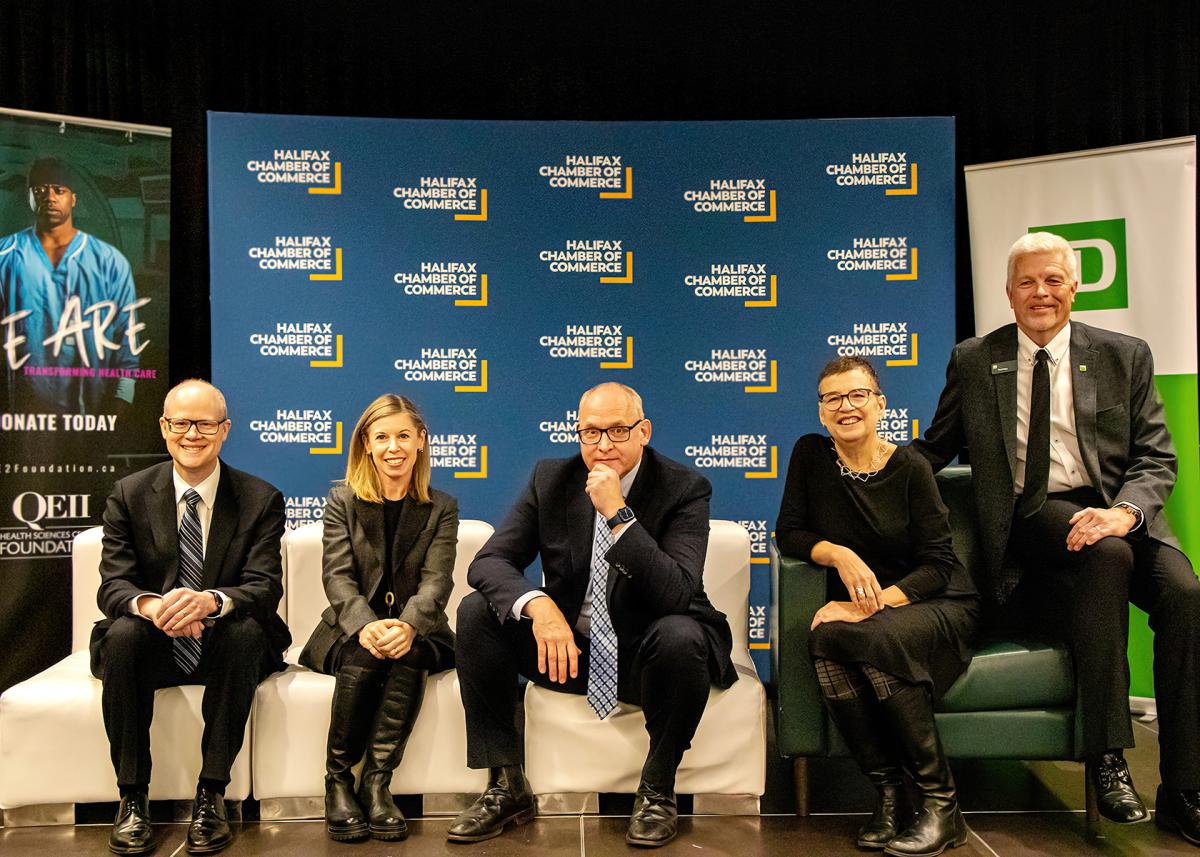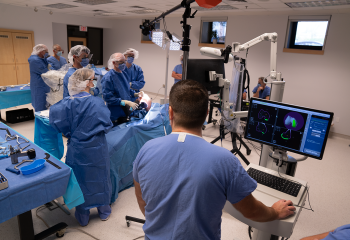
Originally published by the Chronicle Herald.
L-R: Dr. Glen Richardson, QEII orthopaedic surgeon; Dr. Janie Wilson, biomedical engineer; Dr. Michael Dunbar, QEII orthopaedic surgeon; Susan Mullin, president and CEO, QEII Foundation; and Paul Way, TD Bank Group, at the Dec. 14 announcement.
It’s the season of giving — and TD Bank Group is taking part in a big way.
On Dec. 14, TD announced it will donate $1 million through the TD Ready Commitment — the Bank’s corporate citizenship platform — to the QEII Foundation to fund a groundbreaking new orthopaedic robot and affiliated research at the QEII Health Sciences Centre. The robot allows for more precision and personalization in knee and hip replacement surgeries.
Thanks in part to donations like TD’s, the QEII is now home to Canada’s second orthopaedic robot, the Mako SmartRobotics by Stryker. This world-leading surgical technology is changing the game for orthopaedics in Nova Scotia.
“By supporting the QEII Foundation, through the TD Ready Commitment, we are contributing to help improve the lives of patients in Atlantic Canada who will benefit from the best technology in orthopaedic surgery,” says Jennifer Auld, vice-president of TD Canada Trust Atlantic Region.
TD’s $1-million donation is a significant step toward the $2.5-million project, which will be fully donor-funded by the QEII Foundation and its We Are fundraising campaign.
For Dr. Michael Dunbar, a QEII orthopaedic surgeon who works extensively with the ortho robot technology; the donation shows researchers, innovators and the medical team at the QEII that TD is proud to help Nova Scotia become a leading province utilizing robotics in the medical field.
“I can see knees and hips in ways I’ve never seen before,” he says. “The robot is the vehicle that’s going to transition us into the new world of patient-specific surgery.”
QUICKER RECOVERY TIME, LOWER REVISION RATES
The orthopaedic robot arrived last fall and has been in surgical rotation at the QEII for almost a year now. By using this technology, patients who need to undergo a knee or hip replacement can expect a minimally invasive surgery with less pain, less bleeding and a quicker recovery time so that patients can have a shorter hospital stay.
Patients will also benefit from customized surgical techniques and greater precision thanks to the robot. This reduces revision rates and allows surgeons to make smaller incisions, preventing soft tissue damage.
“Instead of replacing the whole knee, we can replace part of the knee with more precision,” Dr. Dunbar says. “We used to not be able to do that as reliably with manual instruments.”
Dr. Dunbar says those nervous about being performed on by a robot shouldn’t be. Surgeons are still in complete control and will be by the patient’s side every step of the way. Since using the orthopaedic robot, he’s received nothing but positive feedback from patients.
“It allows us to identify a target that’s very specific to you and enables us to hit that target every time,” Dr. Dunbar says. “That’s what the renaissance is with the robot. That’s the big step forward.”
Another important piece of the project, which is also supported by donors, is research. Dr. Dunbar along with a team of orthopaedic and robotic experts are conducting critical research to validate the efficacy of robotics in hip and knee surgeries.
“What’s most interesting for me… is that all the data put into the robot – the images and everything that happens at the time of surgery – is all saved.”
The data the robot collects while performing surgery allows doctors, other medical professionals and students to better understand each patient’s needs, improve patient outcomes and tailor their approach to give excellent, more personalized care.
It’s investments from donors like TD that help make innovative solutions a reality, says Dr. Gail Tomblin Murphy, whose team at Nova Scotia Health’s Innovation Hub was instrumental in bringing the technology to the QEII through industry partnerships.
“Donors like TD along with our clinical, academic, research, innovation and business partners, are allowing Nova Scotia Health to spearhead world-class innovation and research through robotics technologies and optimize care and outcomes for patients and families,” says Dr. Tomblin Murphy, vice president, research, innovation and discovery, and chief nurse executive of Nova Scotia Health.
REVOLUTIONIZING ORTHOPAEDIC SURGERY
This $1-million donation is TD's largest ever donation to a healthcare centre in Atlantic Canada. Through the Better Health area of focus from the TD Ready Commitment, TD aspires to support innovative research, solutions and technology that are aimed at creating more equitable health outcomes for all.
Susan Mullin, president and CEO of the QEII Foundation, is grateful for TD’s donation because of its revolutionizing impact on orthopaedic surgery in Nova Scotia.
“It’s the generosity and vision of our donors like TD that empowers the QEII Foundation to invest in the extraordinary, so that surgeons, scientists and collaborative researchers can make major advances in how we deliver care,” she says.
To learn more about ortho robotics, visit https://qe2foundation.ca/orthopaedic-surgical-robot.
